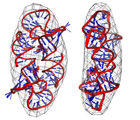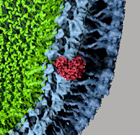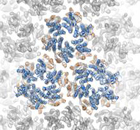The Specialized Centers for HIV/AIDS-Related Structural Biology integrate a variety of techniques from structural biology, biochemistry and cell biology to capture in unprecedented detail the three-dimensional structures of HIV components bound to human cellular components, such as proteins, RNA or DNA. This information will help elucidate how the different components interact and reveal new approaches for disrupting those interactions, potentially leading to new targets for HIV therapies.

NMR structure of a retroviral RNA packaging element fitted to averaged cryo-electron density. Credit: CRNA
Principal investigator: Alice Telesnitsky, Ph.D., University of Michigan
This center studies the structural biology of viral RNA and its interactions with viral and host proteins. Because RNA is less amenable to structural analysis than proteins are, the researchers are developing approaches to overcome this technical challenge. Their work could help identify RNA-based targets for HIV treatments as well as shed light on the multiple biological functions of the viral genome.

Hexagonal lattice of HIV-1 CA (gold) serves as a template for assembly of a hexagonal lattice of the restriction factor TRIM5a (blue). Credit: CHEETAH
Principal investigator: Wesley Sundquist, Ph.D., University of Utah
This center is using computational and experimental methods to analyze HIV molecular complexes and determine how they interact with and commandeer cellular machinery to traffic throughout the cell and form new virus particles. By visually reconstructing various elements of virus particle assembly and trafficking, the center aims to develop HIV into a model for studying how other human viruses interact with cellular hosts.

Dimeric Fab-integrase complex determined by single particle cryo-electron microscopy. Credit: HARC Center
Principal investigator: Alan Frankel, Ph.D., University of California, San Francisco
This center is developing new tools and methods to create a complete picture of HIV-host cell interactions occurring during the early phases of the virus life cycle. The center focuses on key HIV proteins that perform important regulatory and accessory functions.

HIV protease about to clip a Gag precursor polyprotein. Credit: HIVE Center
Principal investigator: Arthur Olson, Ph.D., The Scripps Research Institute
This center focuses on interactions of major HIV enzymes, structural proteins and their partners, particularly as the virus mutates. Through structural, biochemical and computational studies, the research team is investigating how these interactions affect the virus’s function and its response to selective pressure imposed by drugs used in AIDS therapy. The details could improve understanding of drug resistance and lay the groundwork for developing anti-HIV treatments that exploit the virus’s biology.

All-atom model of HIV-1 capsid assembly superimposed onto an electron density map. Credit: PCHPI
Principal investigator: Angela Gronenborn, Ph.D., University of Pittsburgh School of Medicine
This center specializes in developing a structure determination pipeline to image pivotal events occurring right after the virus fuses with the host cell. The center is establishing a framework for computationally predicting important cellular partners for HIV and for experimentally validating such predictions.